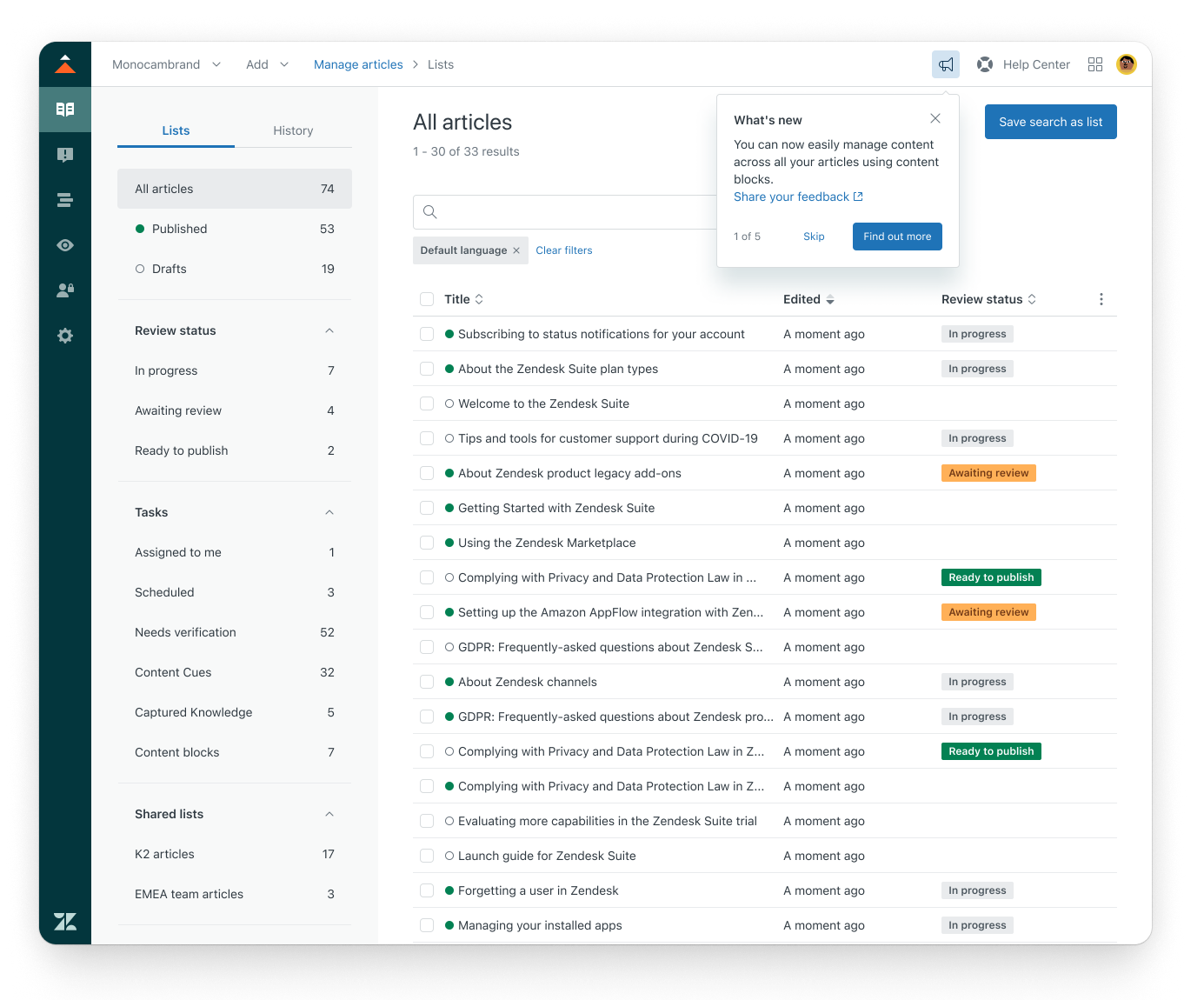Case study —
Content blocks
At the end of 2020 I have became a Lead product designer overlooking Knowledge management platform.
Around 2021 we have identified a need for more modular content creation and management process. This case study explains our discovery, solution, and implementation journey. I was working on this project for the whole 2021 together with my scrum team and a product manager.
Content blocks are segments of text that are grouped and reused across one or more articles in your help center or across different help center brands in your account. Users can create a content block from their help center or from within an article where they want to use the content block. In both cases, the content block appears in the content block list, where users can view the content block and where it is used, edit the content block, or remove the content block from your help center. Guide admins can create and insert content blocks on any article. Agents can only create and insert content blocks in articles that they have permission to edit.
Zendesk Knowledge management platform (Zendesk Guide) used to create, share, and manage knowledge within an organization to improve customer support and service efficiency.
Effective knowledge management in Zendesk not only improves customer satisfaction by offering quick access to information but also enhances operational efficiency for support teams. By leveraging a centralized knowledge base, organizations can foster a culture of knowledge sharing, leading to better service delivery and a more informed customer base.
Design process
At Zendesk, cross-functional collaboration is at the heart of our product development process. We believe that involving everyone— product designers, product managers and engineers—right from the start makes a big difference. Our engineers are not just behind the scenes; they actively participate in research, help define requirements, and join in brainstorming sessions to validate solutions. It’s common to see them engaging in user interviews and working side by side with designers and product managers to synthesize research findings. This collaborative approach ensures that we create products that truly resonate with our users. Beyond the people who design and build Zendesk, every release is supported by teams like Localization, Go-to-market, Documentation, Customer Advocacy.
At Zendesk we have developed our own product development process called Tripple Diamond, which is based on the classical Double Diamond process with one additional diamond. In our experience, it often creates the expectation that at a certain point, designs are completed and handed off for implementation by engineers. Which is usually not the case. In nearly all situations product designers are quite heavily involved in supporting and continuously refining the solution based on the new findings and constraints that were discovered during the development stage.

Zendesk Triple Diamon
The diamonds are useful in helping people understand the divergence and convergence at the core of discovery solutions to customer problems. We go wide, then decide.
Moving along the process, uncertainty decreases over time as we hone in on the right solution. Throughout, we learn about how customers are responding to our product, and we tweak accordingly.
- Problem discovery: Investigate the problem space and uncover customer pain points and figure out what problem we're trying to solve by understand the knowns and unknowns.
- Problem definition: Findings about the users’ context, common scenarios, goals, tasks are summarized in a solution-agnostic way.
- Solution discovery: Cross-functional identifying, exploring, and generating potential solutions to address a specific problem and to understand how we want to build our solution.
- Solution validation: Shortlisted concepts are tested using a throwaway prototype to quickly solicit feedback from customers.
- Feature development: Cross-functional partners work together to build out the user experience, iterating the design from early-stage concepts to working product. Development work is fully underway in parallel with design iterations.
- Rollout/ General availability: The product/feature is commercially available, meaning it can be purchased or is part of a purchased plan. Localization and documentation are complete. Before a product or feature is Generally Available (GA), we have the option to release it to customers as an Early Access Program/Beta.
Problem discovery and definition
To provide a rich and consistent ticket deflection experience to end-users, content managers have to re-use content (an article, an attachment, image, or a paragraph) across a Guide instance. Multi-brand customers have standard, global articles which needs to be published to all end-users, regardless of brand. Today content managers duplicate content for each brand which increases inaccuracies and content management costs.
Innitial discovery research has indicated that customers need to replicate somewhat similar content that migth have different images, product, brand and/or modified text content. Meaning that customers had a need for some shared and some unique article content more than exact copy of the same article living in multiple instances. The idea of reusable content blocks came around.
Reusable content blocks would enable editors and publishers to have same content blocks living in multiple articles. With this concept we have made lots of assumptions around article reusability, supported formats, translations and overall article management that will be costly in terms of usability and development. We needed to user test these assumptions and make an assessment of further steps.
Hypotheses
Hypothesis 1: Reusable content blocks will help content contributors to eliminate duplicate content issue within Guide.
Hypothesis 2: Content contributors only need basic formatting options to create reusable content blocks.
Hypothesis 3: Reusable content blocks will help content contributors to create, update and manage articles faster and more effectively.
Hypothesis 4: Anyone can create and manage reusable content blocks in Guide.
Key questions
Validate reusable content block concept:
- How content contributors understand reusable content blocks?
- Are content blocks helping to eliminate duplicate content problem?
- How do we define a reusable content block?
Validate accessibility and permissions of reusable content block:
- Who can create new content blocks?
- Who can view all content blocks?
Validate reusable content block workflow:
- Who can edit/delete reusable content blocks? How these edits will affect other articles that are using these blocks?
- How reusable content blocks are being used?
- What attributes/metadata should reusable content blocks have?
- What kind of workflow content contributors expect to initiate maintaining and updating content blocks?
- How content managers expect to manage reusable content blocks?
- What is expected translation workflow with reusable content blocks?
Validate reusable content block formatting options:
- What type of content is being reused the most?
- Do basic formatting options eliminate the majority of use cases?
User research - storyboard
During our validation we have introduced the story board in order to put customer minds in perspective, after the storyboard, and some open ended questions to understand how customers are dealing with duplicate content and content blocks that are currently reused across their knowledge base, we have jumped in and enable feature flag on their account. We have prepared 3 tasks to test how they will create, insert and edit content block in their Guide account.
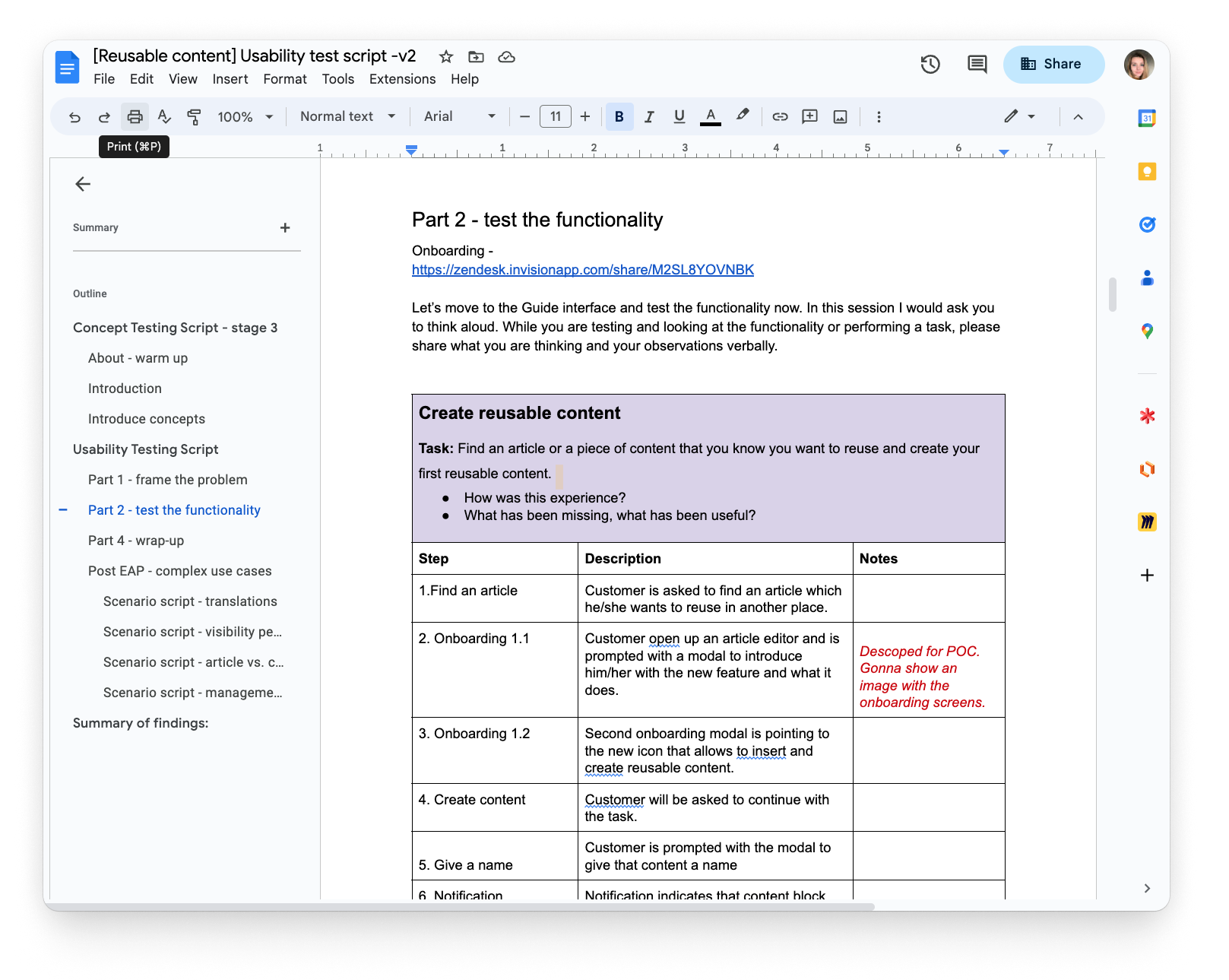
Since our prototype was quite limited after the live validation depending on the customer and their needs, we have prepared 4 additional story boards that were covering complex use cases: translation workflows, management at scale, visibility permissions use case, content block workflows scenario. This has allowed us to gather feedback on multiple layers of the prototype and test our assumptions.
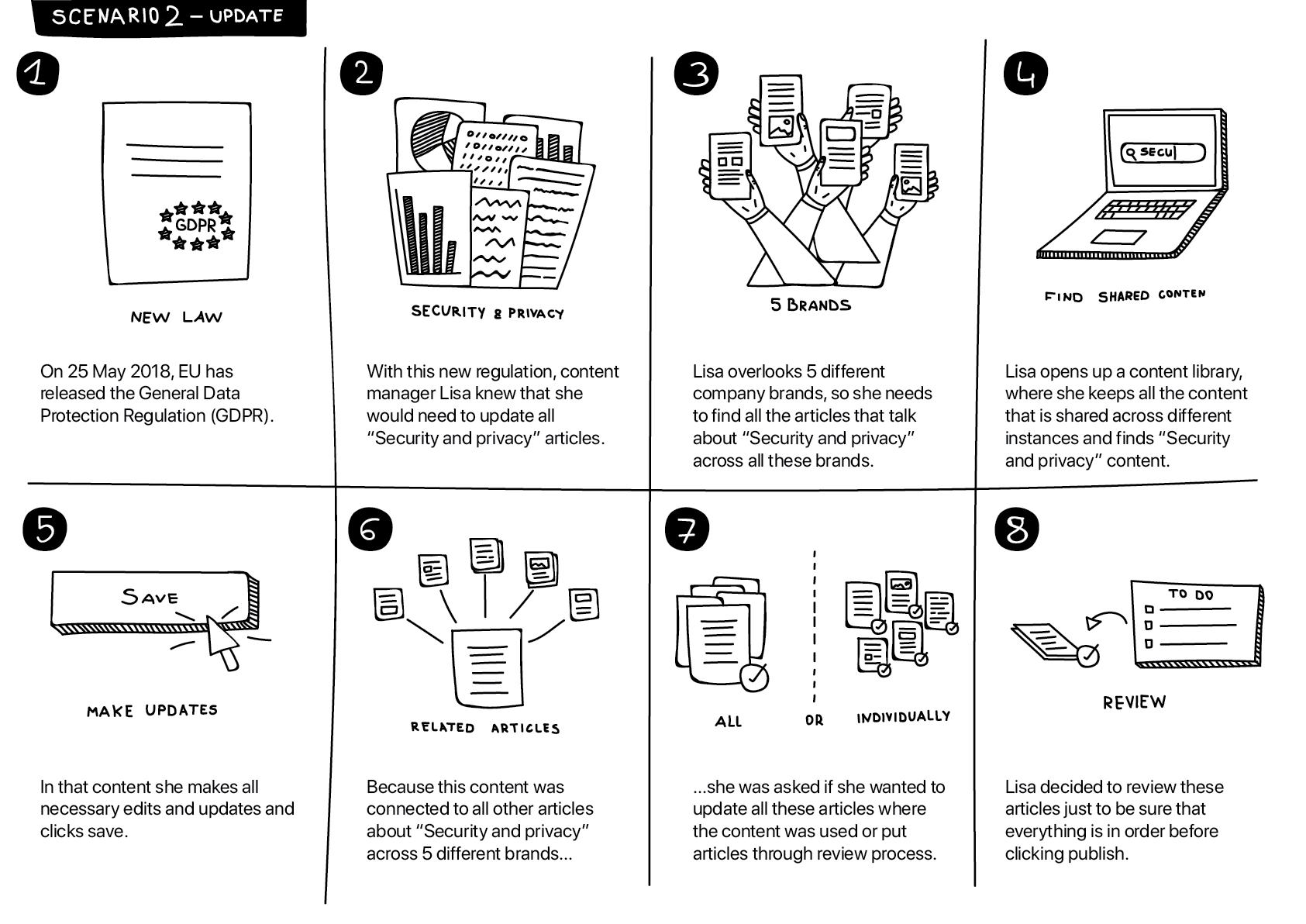
After the research, we have synthesized the data and used affinity mapping to create clusters with key takeaways:
- Majority of customers have a need to reuse pieces of content more than a whole article. Few key use cases would be a part of a paragraph, or images, code blocks. Right now customers link to other articles with that content
- Customers reuse product names, text, images, code snippets, videos, attachments, tables
- Customer identify a need to reuse content by looking at user workflows, advocates give insights, interlinking happens organically, internal processes
- Formatting options: Few different styles of content blocks to choose from. Missing underline, image, links, videos, table, attachments, some customers were very particular how the content was rendered out in the html.
- Few customers were taking a moment to understand why they needed to save an article. But the majority of them expected to have a block created on the click of a modal save
- Creation and insertion of content blocks should be based on the same permission model as article creation and publishing
- Management interface would be necessary, because customers would expect to have 50 to 200 content blocks

Solution discovery and solution validation
With the clear direction and problem definition we have moved ahead to finding the right solution iteratively. We have decided with the product leadership to move ahead and target an early access program (EAP) where customers within thin EAP will be able to activate content block functionality on every article individually. We took this couscous approach to have a more controlled environment. Historically we know that customers are using Source code functionality to insert any custom HTML / CSS or any script components that we can not control or predict. Therefor if customers are having issues with article rendering they can revert the article to the original state by disabling content blocks.
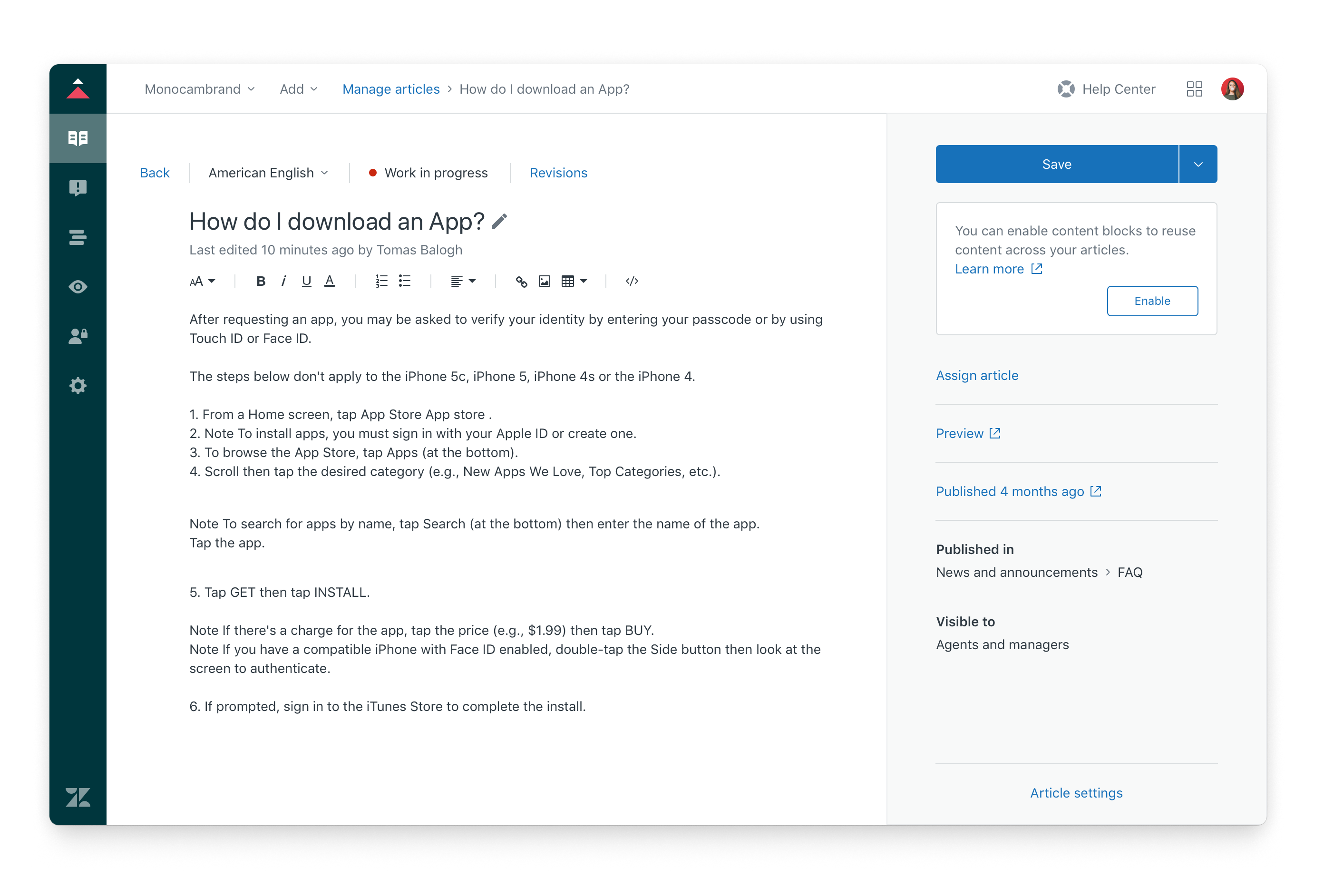
Each article will have a callout in the sidebar that allows customers to enable content blocks functionality
Article conversion overlay to enable content blocks.
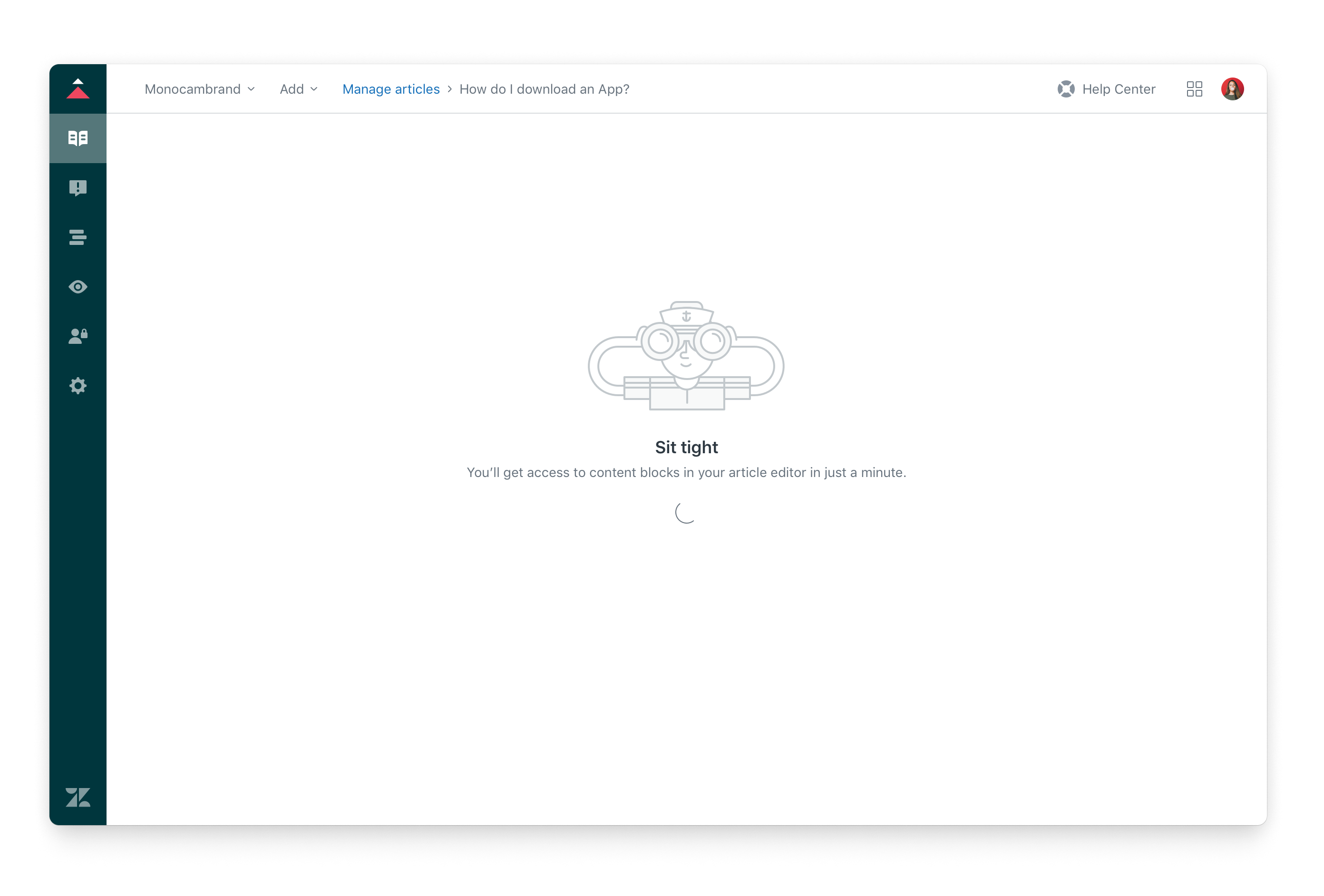
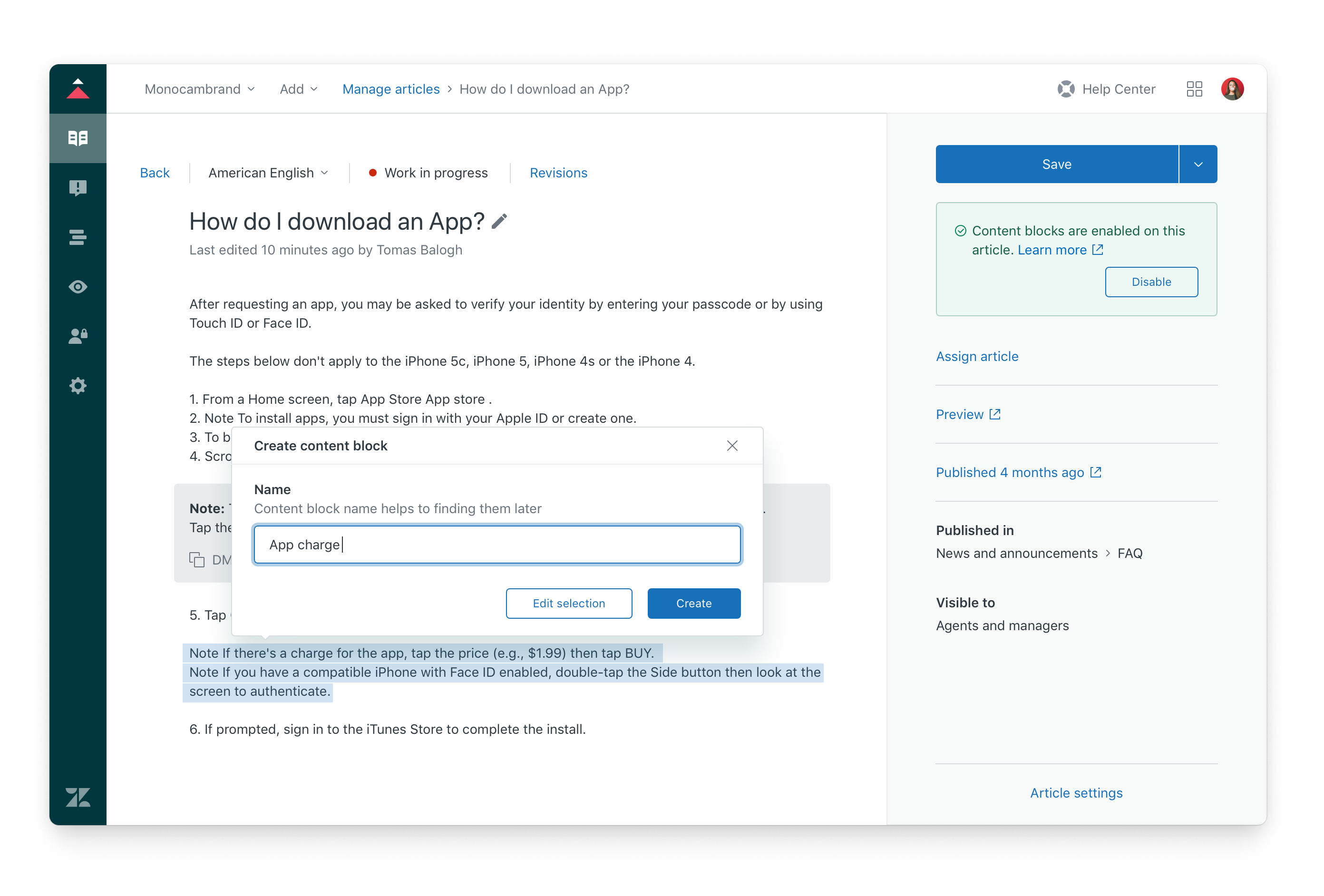
Article that has content blocks feature enabled. and content block creation contextual experience.
Visual preview to insert content block from a modal.
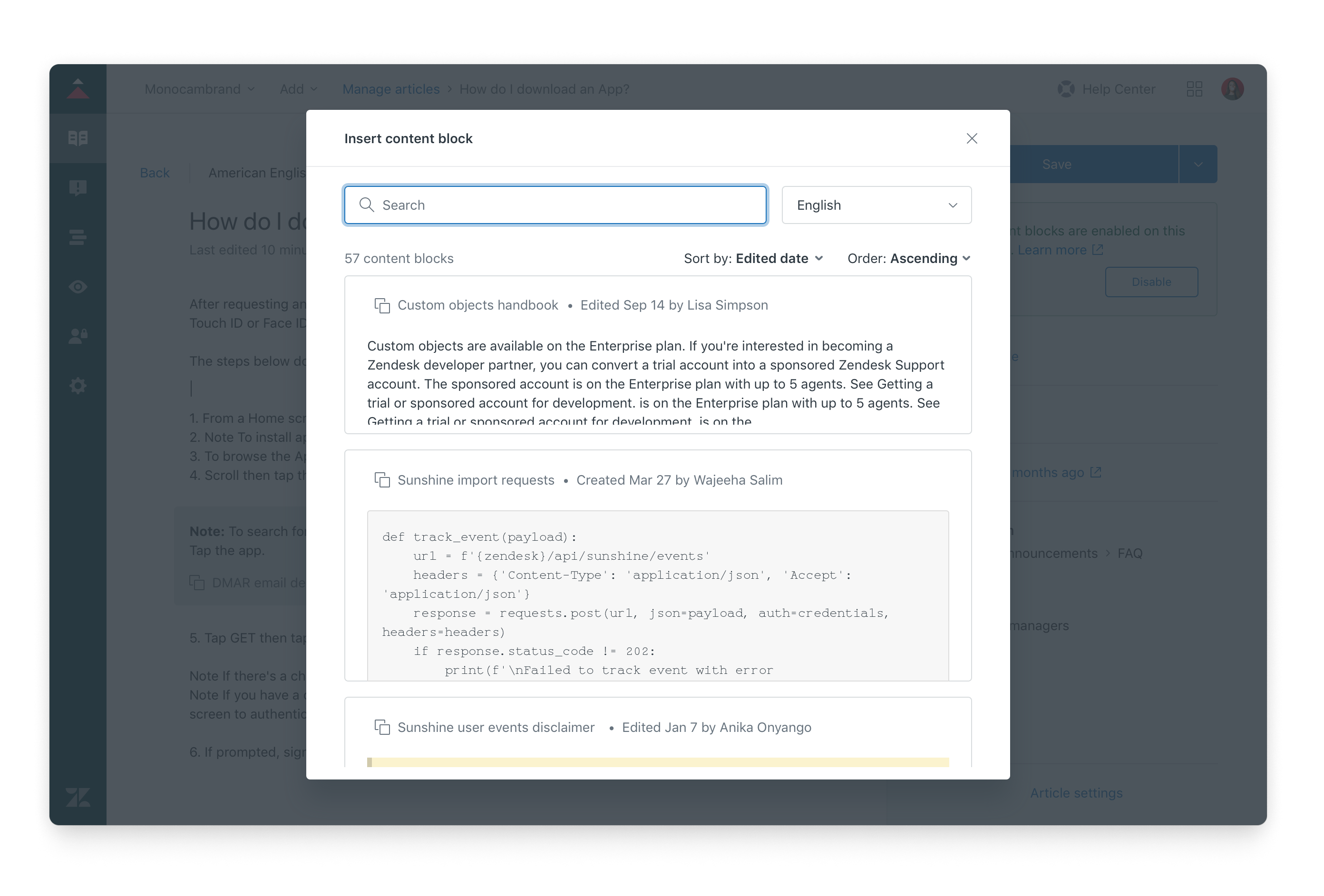
Early access programe
After we launched Content Blocks EAP we ran user research interviews to understand the customer experience with content blocks.
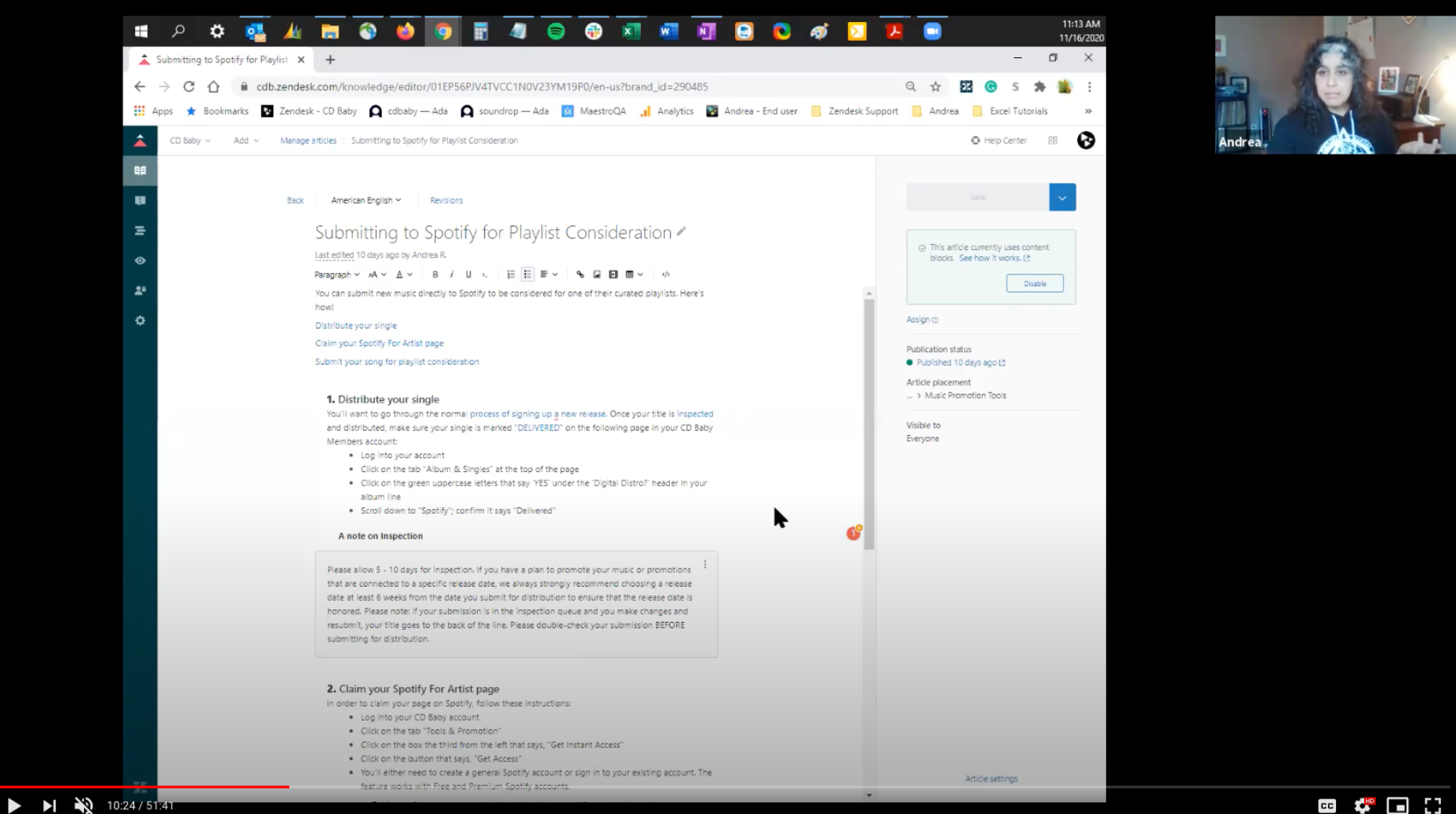
Interviews
45-50 minute Zoom interviews with 10 customers. Customers answered questions and have shared their screens and showed us how they use / do not use content blocks.
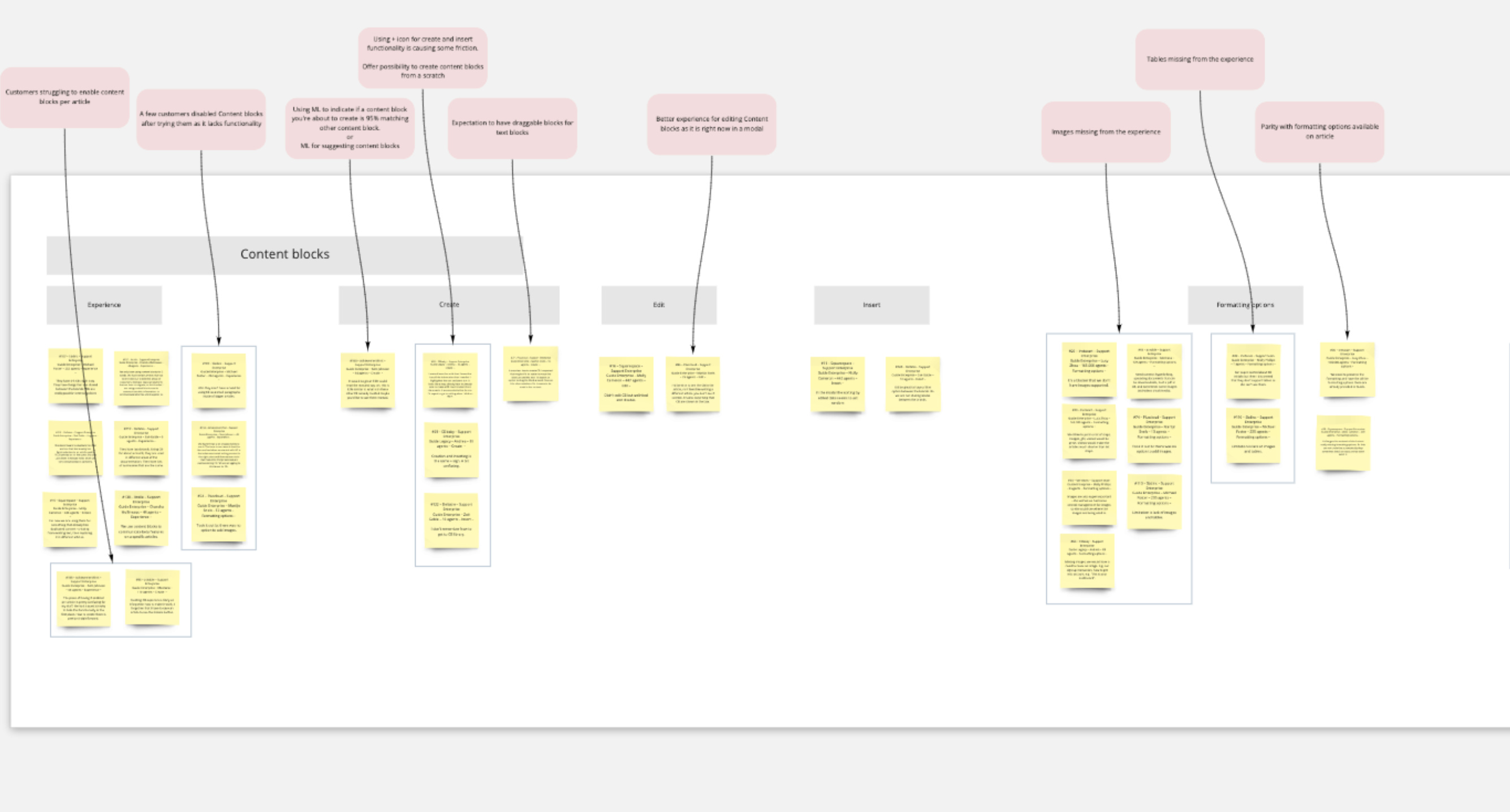
Analysis
Interpretation sheet that helps to break down the feedback into categories and affinity map that groups them together.
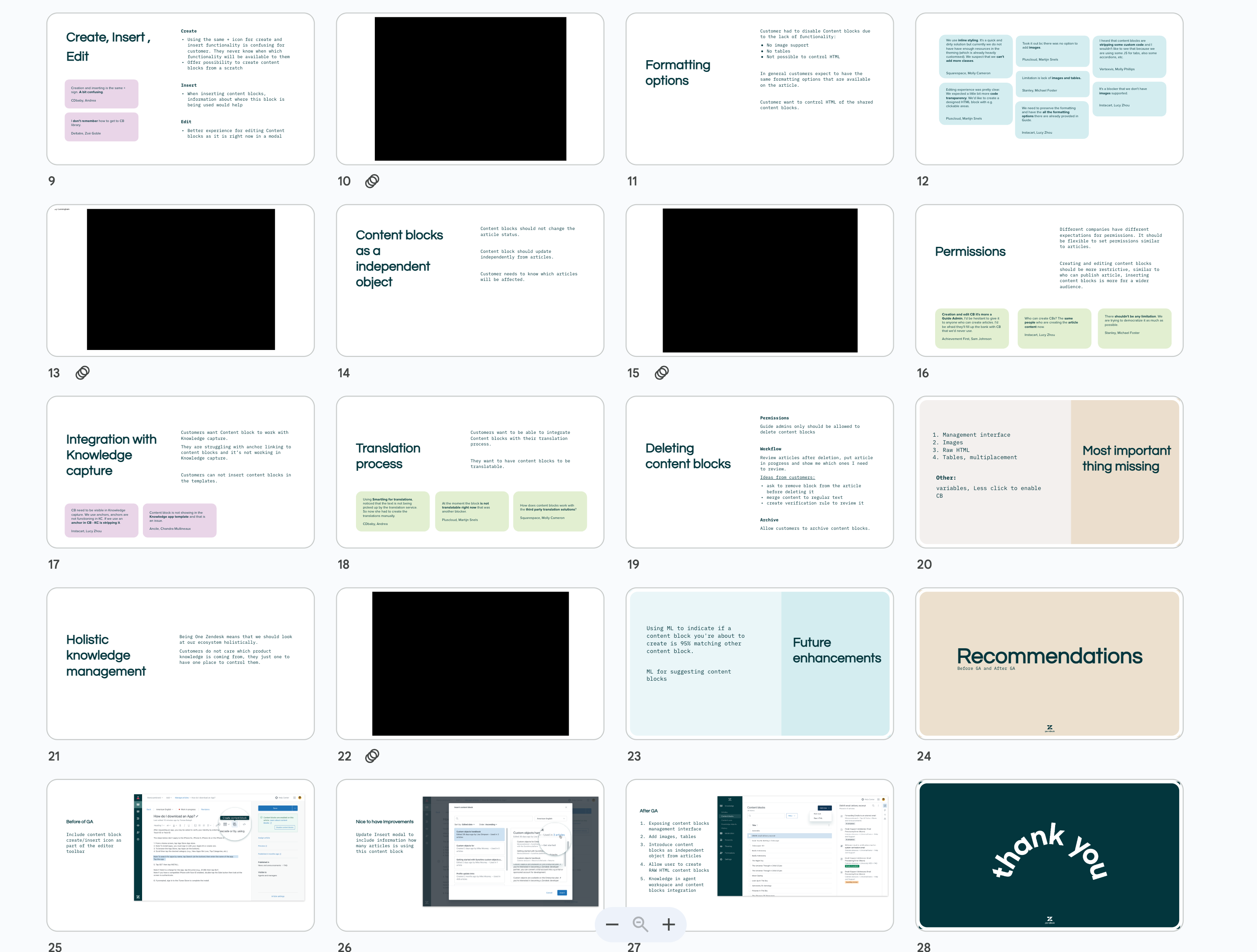
After the research, we have shared our key takeaways with business stakeholders and the scrum team to inform our learnings and identify the next steps that will lead us towards the rollout of this functionality.
Rollout
The goal of the was to offer Content Blocks in General Access to all our Enterprise customers. At the time of launching it, our customers will be able to have some basic editing functionality.
The vision of this initiative is to provide a flexible and utterly modern content creation experience which removes the need to use multiple editing tools and reduces the effort of repetitive content update tasks.
Our Enterprise customers have robust knowledge bases. They may have many brands, many locales, tens of sections, hundreds of articles. Maintaining this knowledge is time and resource consuming. At the same time our customers realise that some of the content is often repeated across different articles, locales, brands. Keeping it up to date is an unnecessary overhead and a cumbersome task for Knowledge Admins and Agents.
Our Enterprise customers would like to have a tool that would allow them to create engaging content (rich text, images, videos, gifs, pdfs, etc.) that helps their customers solve their problems faster. They need to be able to edit, manage and reuse it across their whole Knowledge Base.
Onboarding
We put a lot of time and effort into developing the new Content Blocks feature, and we want our customers to fully understand and appreciate its capabilities. That's why I focused on creating an engaging onboarding experience that really showcases what Content Blocks can do. I designed an interactive tour that includes an animated video, making it easy for users to grasp the functionality and see its potential in action. This onboarding process is crucial because it helps ensure that our customers not only adopt the feature but also feel empowered to use it effectively in their own projects. By making the learning experience enjoyable and informative, we can help our users unlock the full power of Content Blocks.
Investing in a robust onboarding experience yields significant returns for businesses:
- Reduced time to value: A well-designed onboarding experience accelerates the time it takes for users to see value from a new feature. This can lead to quicker adoption rates and higher satisfaction.
- Lower support costs: When users are effectively onboarded, they are less likely to encounter issues that require support. This can reduce the burden on customer service teams and lower overall support costs.
- Increased user retention: Users who understand how to use new features are more likely to continue using the product. This improves retention rates and reduces churn.
